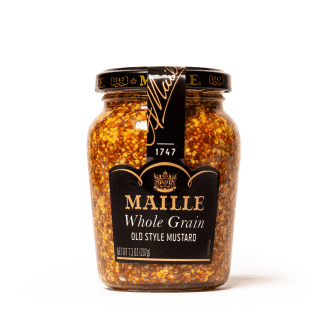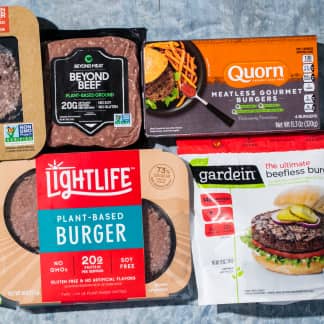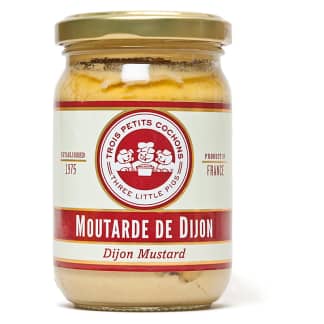We love whole-grain mustard. It’s a welcome change of pace in sauces, it’s delicious on a sandwich, and it’s traditional in dishes such as German potato salad. Whereas many other styles of mustard are made by finely grinding the seeds to form a smooth condiment, whole-grain mustards contain seeds that are either whole or coarsely ground. The seeds add not only visual appeal but also some pleasant textural contrast. We wanted to learn more about the variety of whole-grain mustards on the market, so we purchased five different kinds and sampled them plain and with pigs in a blanket.
Whole-Grain Mustards Vary in Texture
The seeds in two of the mustards were coarsely ground. In terms of texture, one of these mustards was a little thin; the other was thick and cohesive.

Most commercial mustards are made with brown or yellow mustard seeds. In the mustards we tasted, they were coarsely ground or left whole.
In the other three mustards, most or all of the seeds were whole. All five of the whole-grain mustards had more texture and crunch than most other mustard styles, but those with intact seeds had the most, with seeds popping between our teeth as we ate. Two had especially large seeds, and tasters said that those big, glossy yellow and brown seeds reminded them of caviar. Given the “serious crunch” and striking appearance of those two mustards, our tasters described them as “more of a cheese-board thing than a hot dog mustard” and noted that they would be ideal for garnishing foods such as deviled eggs or roast pork. The seeds in the third mustard were a bit smaller, making it a more versatile option.

Finding the Right Flavor
Whole mustard seeds are bitter and a little nutty. It’s only when they’re crushed and combined with liquid that a reaction converts the bitter compounds to spicy compounds. Since the seeds in the whole-grain mustards were either left intact or just coarsely ground, it’s no surprise they were milder than, say, a typical Dijon mustard, which is made from finely ground seeds and thus spicier.
The whole-grain mustards tasted earthy and pleasantly bitter rather than spicy. Many contained white wine or whisky in addition to the vinegar and water commonly used to make commercial mustards. All the whole-grain mustards were “vibrant” and “tangy” and "great with savory food."

The Best Whole-Grain Mustards: Grey Poupon Harvest Coarse Ground Mustard and Maille Old Style Mustard
We named two winners, one coarsely ground and one whole seed. As its name suggests, Grey Poupon Harvest Coarse Ground Mustard contains coarsely ground seeds. Those seeds still popped pleasantly and offered “a bit of textural contrast.” It has gentle, mustardy heat and bright acidity. We also really liked Maille Old Style Mustard, which contains lots of intact seeds and offers more crunch and pleasant bitterness. Both add a nice pop to salads or dressings. When you want the visual appeal of whole seeds as a final garnish or in something like a compound butter or potato salad, we recommend using the Maille Old Style Mustard.
- Taste plain
- Taste with pigs in a blanket
- Samples were randomized and assigned three-digit codes to prevent bias
- Bright and vibrant
- Seeds provide pleasant textural contrast














